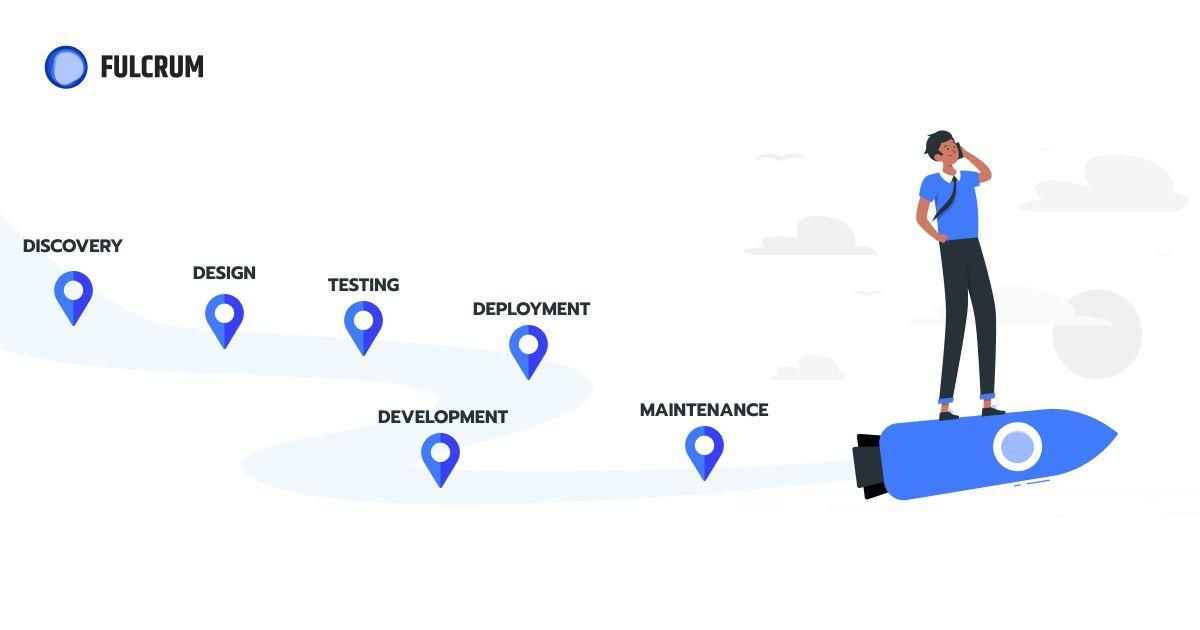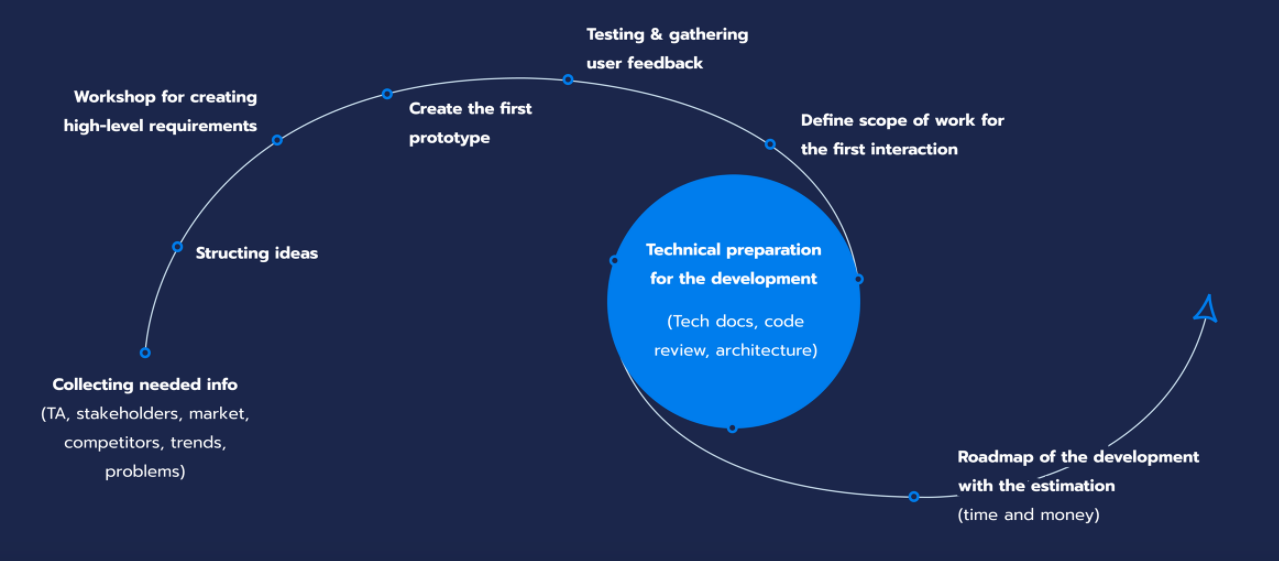Behind The Scenes of Fulcrum’s SDLC Process
After you complete reading this guide, you will not just get the knowledge on the topic you’ve typed in the google search box this morning. But you’ll get the power that allows you to see strategic steps you need to take in developing your own software.
Alright, let’s start with the basics – WHAT, HOW, and WHY.
WHAT Is SDLC?
In plain language, Software Development Life Cycle (or SDLC) – is your blueprint to creating a software application. It’s a clear step-by-step process designed for successful analysis, design, development, and release. Each step of the development process can be converted into tasks making it effortless to assign, complete, and measure.

Skipping any step of the software development life cycle is a dangerous game. It increases your chances of product failure. Better stay on the safe side!
Now let’s move to HOW…
HOW SDLC model works
As we’ve discussed earlier, developing any type of software is a multi-step procedure. This process can consist of a few essential stages and also include some extra ones, depending on the product type.
At Fulcrum, we break down the Software development life cycle into 4 different phases:
- Discovery
- Design
- Development
- Release & Support
4 Phases of Software Development Model
Discovery Phase
The discovery phase is your first step in software development. If you are a business owner looking to complete your project on time and within the specific budget – this step is a must-have! The main goal is product validation through in-depth research & planning. It helps to verify that the concept of your future product is viable, feasible, and usable.
At Discovery phase, our team usually completes the following tasks:
- Collecting data on TA, stakeholders, market, competitors, trends, problems.
- Structuring main ideas of your future app.
- Creating high-level requirements.
- Creating the first prototype.
- Testing & collecting user feedback.
- Defining the scope of work after the first interaction.
- Performing preliminary tasks for development (tech stack final, integrations overview, cloud architecture, system architecture, database schema & API design);
- Creating a product development roadmap.

Discovery is a strategic step in setting up your project development process well. As a result, you’ll have a complete understanding of the scope of your project, goals, and possible risks. Purpose of the Discovery Phase:
- Determine Business goals, needs & product vision.
- Mitigate the costs for development
- Identify & downplay possible risks
- Create a product architecture
- Create a roadmap for product development.
Watch a short video to get more valuable insights.
If you want to know more about the Discovery Phase, its benefits, main activities, tools, etc. click here.
Design Phase: UX/UI Design
Design is not just a good-looking app, but a profitable phase in your SDLC model. In fact, it can increase your conversion rates up to 400% as a result of a great user experience.
We believe that the ideal interface for your app is built on your user needs and competitor analysis. Our Fulcrum designers also take into account technical constraints and system requirements.
(Like the admin panel design that can only be developed from ready-made components of the frontend framework. It allows to reduce development costs).
During the Design stage, we:
- Design a product prototype;
- Create a UX audit (to make sure designs meet the objectives of the Discovery phase);
- Create a final UI design.
We don’t create for the sake of creating. And here’s why we consider every possible user journey before jumping into the project. In case you need a website or an app – let our team of designers create a winning UI/UX design tailored to your project.
Product Development Phase
The next one is a core phase of the product development planning – the actual product development… shocker! PRD, roadmap, and product architecture of the project is being set up at this stage. It is more convenient and secure to develop these within a single development team.
Here at Fulcrum, we’ve got you! We gather pro-team dedicated to your project – from business analysts, project managers to designers and developers – all under one roof. We support businesses from the initial idea all the way to the product launch.
Check out the full presentation on the Development phase.

Product Development Workflow In Details
Before the project starts, our developers get familiar with relevant documents to create repositories, file structure and connect dependencies.
During the dev procedure, the team develops cloud architecture using top security and optimization practices. These processes are managed by the technical lead of the project. The Fulcrum team sets up 3 basic environments (test, UAT, production).
After the Fulcrum devs design testing deployment automation, the app goes through the first release. With any changes in code on the desired branch, the codebase is being tested again and a new app release is created.
Each task implies basic design, development, and testing. Any changes to the codebase are performed only through the gitflow practices. For the task description and statuses, we use the Jira task manager service.
After the developer completes the task, its status is verified by QA. Finally, it’s time for the deployment and the new release.
Release & Support Phase
Toward the end of your product development life cycle, after all the hard work has been done…
Your product is finally LAUNCHED! Hooray!
But, the mission is not yet completed. In the first months of a product’s life, most apps go through minor or major improvements, not to mention bugs popping up here and there.
At Fulcrum, we don’t just leave you there on your own, we provide a support service for our clients. Depending on the system requirements, we form the support team and create a list of tasks.
Typically, the Support Service includes:
- bug fixing;
- system scaling;
- data optimization;
- user feedback analysis;
- dependencies update;
- optimization of infrastructure costs;
- etc.
One of the benefits of working with the Fulcrum team is the ability to get the Support service at any time after the development phase is completed.

Why Choose Fulcrum For Your Software Development Planning
Fulcrum Rocks helps businesses launch mobile & desktop apps from scratch. Our team performs all SDLC phases – from discovery to product release & support.
Have a look at Fulcrum’s 4-stage software development life cycle:
| Discovery | Design | Development | Release & Support |
|---|---|---|---|
| Preliminary planning: business goals, terms, possible risks, costs. At this phase, we build the product architecture & roadmap. | We create the app design and make a UX audit. | We create the product architecture, test for compliance with all the requirements, and write documentation. | We help launch the app and provide support. |
Going through the entire software development process is a win-win for clients and our Fulcrum team – we produce great results working as a full-product development team; our clients don’t waste their time, money, and nerves on gathering a qualified team for each new SDLC phase. Agile software development and unparalleled service are guaranteed!
Take a look at the full list of Fulcrum projects.
Fulcrum Rocks – We Help Develop Great Apps
We value a strong partnership between the development team and a client throughout the entire product development life cycle and beyond. Why? Simple, it brings great results! Fulcrum has everything you need to launch an app of any kind and scalability from scratch:
- A dedicated pro-team (developers, designers, analytics, marketing specialists, quality assistants, etc);
- Off-shore & in-house approach. Fulcrum Rocks is a Ukraine-based outsourcing company. We take care of HR and make sure the team has resources for performing their job in the most effective way;
- Vivid experience in app development. Currently, we have released more than 15 apps for worldwide clients. Check out our case studies at the Projects section.
- Full budget transparency. We always calculate the approximate budget for your app, as well as include costs that may possibly occur during the development.

